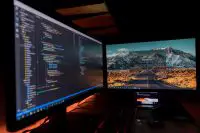Introduction
If you’re new to this site then welcome! This site is all about creating the most ideal gaming, home theater, and man cave set up. This article is part of a series of technical issues that you might experience if you have a dual monitor set-up.
When I first set up my dual monitors with my other gaming set up, I didn’t stop to consider if there would be an effect on how smoothly they ran. If someone doesn’t have a dual monitor set up, they will likely end up ordering that second monitor and then just plugging and playing,
This article will talk about the effect dual monitors have on the speed of your desktop set up and what you can do to make sure there isn’t any noticeable lag. There are only a few reasons that you should be aware of.
So do dual monitors slow down your computer?
As a general rule, dual monitors cause slight but noticeable lag during high quality video watching and gaming unless both monitors are the same resolution and run on a strong PC. Lag happens because the computer has to process the pixels of two screens instead of one. To reduce this, ensure monitors are set to the same performance optimizations (resolution, color format) and install dual monitor driver software if you’re still experiencing major lag.
The solution to monitor lag is actually really simple in more cases than not. You also have to be absolutely sure that all your graphics drivers are up to date! A lot of people overlook this. Even though they’re supposed to update automatically, the most current update doesn’t always go through.
There’s only a limited amount of things you can do if the lag is extremely noticeable. In cases where your drivers are up to date and the format of each monitor is all the same, it might just come down to your system. I can only see your system hardware being the issue if the graphics card is really low quality (gamers shouldn’t have an issue with this one).
Take a look below to see if any of these solutions are things you can try to increase your monitor’s performance speed.
How To Reduce Dual Monitor Lag
Before we start, it’s important to know that most systems should handle dual monitors easily. If your system is newer than 5 years and you know the hardware isn’t a budget set up, then it should be able to handle two monitors easily.
“The first thing you should do is determine whether or not your monitors are the same resolution. If one resolution is 4k and one is 1080p, I recommend bringing the 4k resolution down to something closer to 1080p.” – Mike, Gaming PC Enthusiast
It’s likely that your system is being pushed to the max just by gaming in 4k resolution by itself.
If you don’t want to lose the resolution quality on one monitor, increase the Scaling on the higher resolution one but set each monitor back to its Native Resolution.
You can do this by going to display settings and scrolling down to find the “multiple displays” tab. Immediately you’ll be able to tell if they are the same or not. It’s okay if one is 1920 and one is some other resolution. Just know that there is an extra demand placed on your system to display these two screens. Sometimes it creates an awkward set up if the monitors are right next to each other because you’ll see a noticeable difference in quality.
Changing the color formats to be the same will allow your system to work a lot less hard. Color formats are measured in Bits Per Pixel (bpp), so you want these numbers to be the same on both displays. If they are different, then your system is forced to use DIBs instead of DDBs (not ideal). Go into display settings once again, and check to make sure the color depth on the monitors are all the same. If they are different, then you can be sure your system is falling short on optimizing graphics. Edit the tabs so they are the same number/value.
In summary, be sure that you’ve double checked the following details in regards to your set up
- All your graphics drivers are updated. If you don’t have a gaming set up, then you can skip this part
- The resolutions are either the same or you set the higher one to a lower scaling option, and kept the native resolution on the lower end monitor
- Color formats are the same number or value
- Your system’s graphics cards are within the minimum and maximum spectrum that Steam recommends for the games you’re trying to play
- Your system is newer than five years and/or has had a graphics card or motherboard upgraded at some point within that time period\
How Else Can I Improve My Dual Monitor Set up?
If you know your system is slowing down your set-up because it can’t keep up with two monitors, it might make the most sense to only game on one (and use the other one for Teamspeak or walkthrough tutorials). Gaming on two monitors at once does put a lot of demand on the system especially if you don’t have a dedicated graphics card installed.
If you’re not concerned about speed anymore, there are some other neat things you can implement to make your set up even better. We already talked about drivers and how they can be used to help you auto-optimize your settings. There are also some neat drivers out there that will help you create dynamic wallpapers and implement shortcuts if you find yourself using up to three monitors.
DisplayFusion is one that lets you do just that. This one is not only good for creating dynamic wallpapers but also lets you make keyboard shortcuts even if you don’t have a gaming keyboard. /r/multiwall is a good thread on Reddit where people post about their set ups specific to these features.
Related Questions
How do I know if my system will support dual monitors? Take a look at your graphics card and then take a look at a game you want to play on steam. If that graphics card is in the spectrum of minimum and maximum specs, then you’ll be good to go. If it’s anything less than what Steam recommends for that game, you might have some issues with lag if you intend to use both screens for that game.
What is the best size for dual monitors? The best size for dual monitors doesn’t really matter and here’s why. I do think they should be the same resolution if you intend to use both screens for gaming. If you’re not in that category, then just make sure the color formats are the same so your systems run as smoothly as possible.
Can I create a dual monitor set up with one HDMI cable? There isn’t a way to extend displays using only one HDMI cord. You will have to have at least two cables with one going to each monitor. Splitter cables can work in this case but I personally haven’t tested this out to know if this would also affect the performance of your system.
Conclusion
Having a dual monitor display is an awesome way to go, especially for gaming. I personally don’t use both monitors to game but it’s totally feasible if you know your system can support that.
For activities other than gaming, you shouldn’t experience noticeable lag after implementing all the things we just talked about. I bring this up from time to time, but Best Buy does a really good job with phone consultations if you’re having issues. You just have to give them the exact specs of your monitors and they’ll be able to point you in the right direction. I’m not sponsored at all by them, but I have had good experiences with over the phone conversations. I think they’re probably the best option to go with if you can’t find any other resources on Google. They’ll be able to help you with things specific to your situation.
If I missed anything or if you have questions or comments, feel free to reach out at entertainmentden.ns@gmail.com and I’ll do my best to respond. I’m also currently taking article suggestions if you guys have any so feel free to send those over to. Be sure to check back regularly for new articles and thanks for reading!

